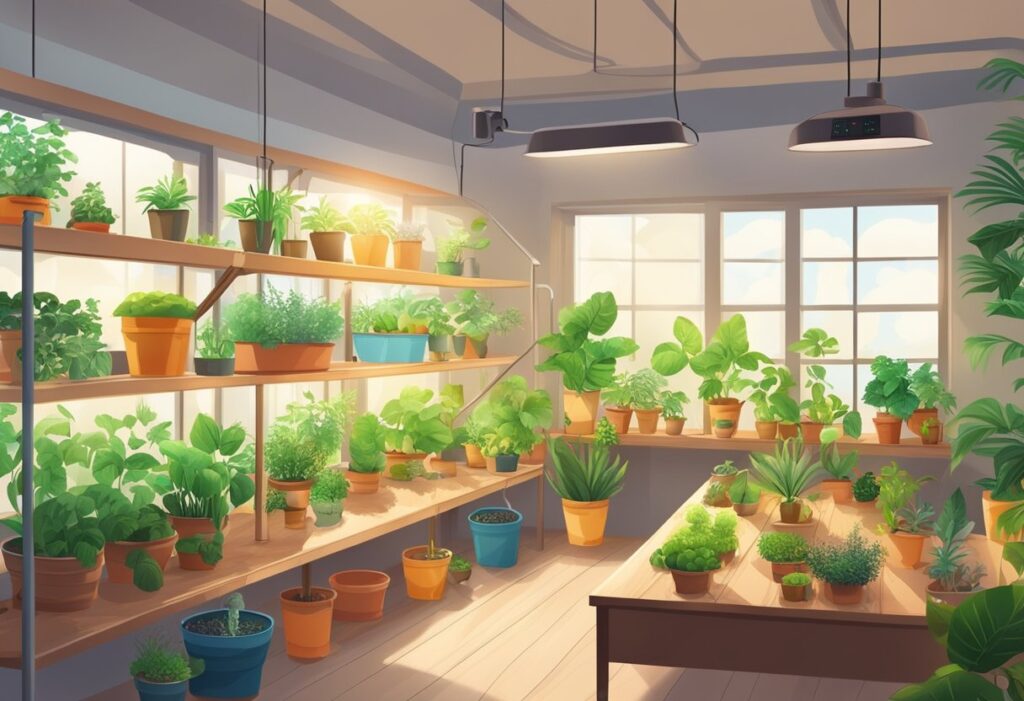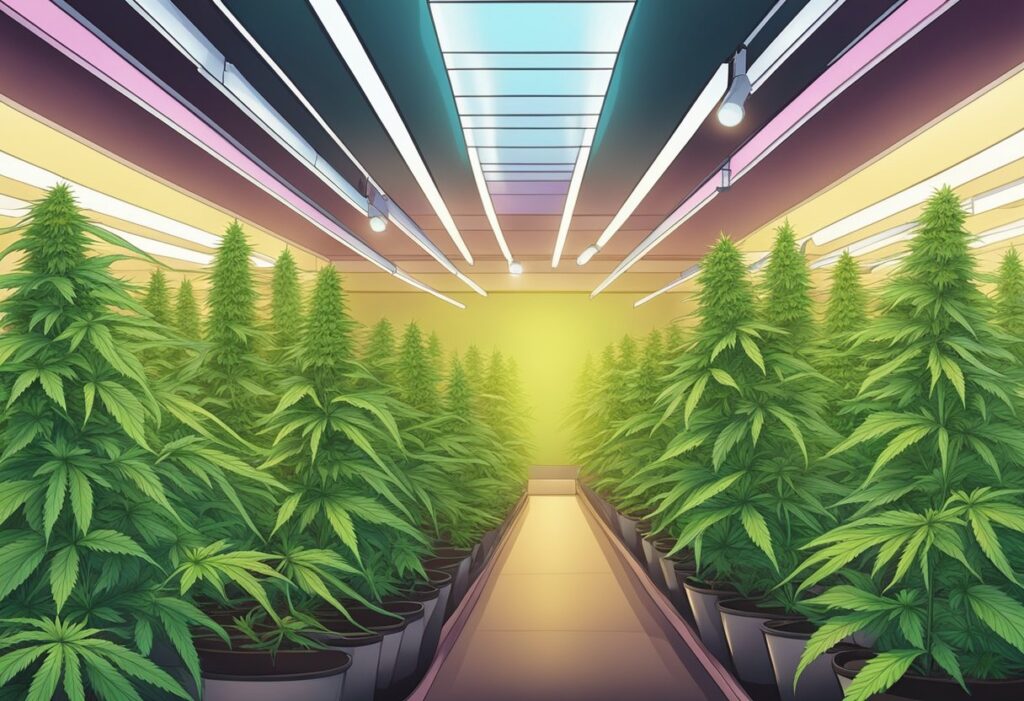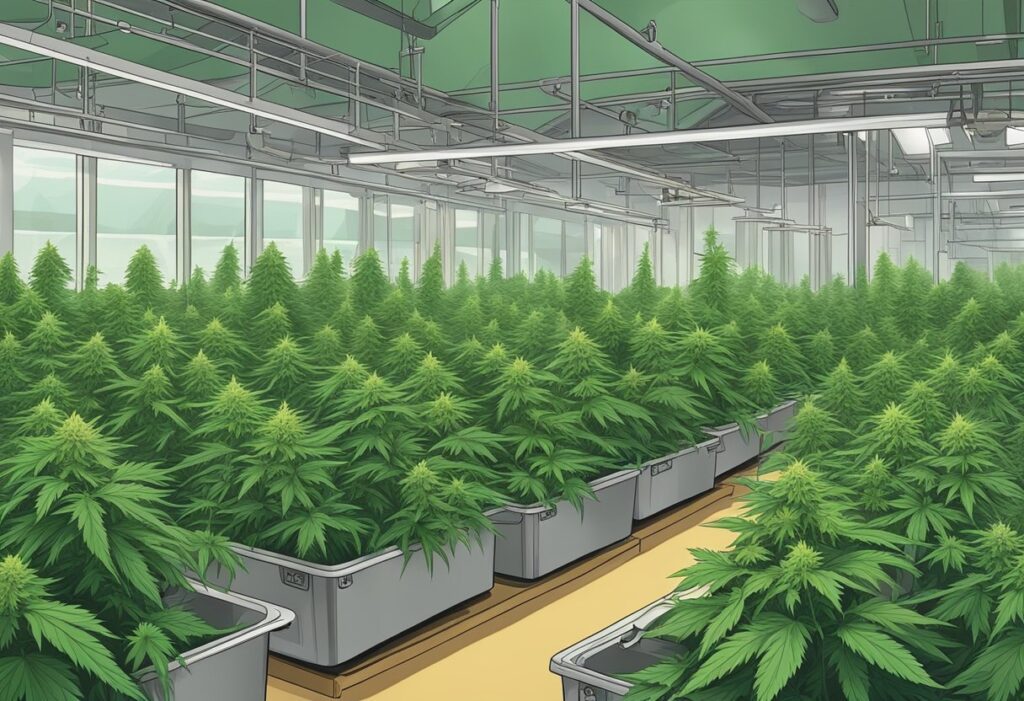
Choosing the optimal setup for your indoor cannabis grow space is essential for a successful harvest. As you embark on this venture, pay keen attention to the location and configuration of the grow area to ensure your plants thrive.
Select a spot that’s secluded and free of disturbances. Basements or closets can serve as ideal locations. Ensure there’s enough room for the plants to grow, as well as for the necessary equipment you’ll need to maintain them. You should also consider legal zoning mandates and privacy concerns, implementing measures like locks or frosted windows for added security.
Proper lighting is critical for indoor cannabis growing. LED or HPS (High-Pressure Sodium) grow lights are common choices due to their efficiency and light spectrum capabilities.
Maintaining the right temperature and humidity levels is crucial for healthy plant growth. Utilize a combination of air conditioners, heaters, dehumidifiers, and humidifiers to regulate the climate.
Fresh air circulation helps manage CO2 levels and prevents mold. Install an exhaust fan to remove stale air and an intake fan to bring in fresh air.
Protect your indoor grow room from unauthorized access and reduce the risk of theft or legal implications. Make your grow space discreet.

Cannabis cultivation indoors requires understanding the lifecycle of your plants, from strain selection to the intricacies of flowering. Paying attention to environmental factors and the right growing conditions will help you maximize yield and potency.
When selecting strains, your choice will significantly influence your growing experience and the final product. Indica strains often have shorter flowering times, while sativas require more time to mature. Autoflowering strains are beginner-friendly as they switch to the flowering phase without a change in the light cycle. Consider THC and terpene profiles according to the effects you desire and select strains that are well-suited to the indoor environment.
Once you’ve chosen your strain, start with germination. This process typically takes 1-3 days and can be done using moist paper towels. As your cannabis seeds sprout, they enter the vegetative phase, thriving under 18-24 hours of light per day. LED grow lights are energy efficient and less intense than other lighting options, reducing the risk of heat stress. During this stage, maintaining a consistent humidity level of 40-60% and a temperature of 70-85°F (21-29°C) supports healthy growth. Your plants need a well-balanced feeding schedule with pH levels kept in the 5.5-6.5 range, whether you’re using soil, coco coir, or hydroponic setups.
Transitioning to the flowering phase involves reducing light to 12 hours a day. This triggers your cannabis plants to start producing buds. Temperature should be slightly cooler, ideally between 65-80°F (18-26°C), to promote terpene preservation and peak THC levels. Managing humidity is critical; aim for 40-50% to prevent mold. This stage lasts about 8-11 weeks depending on the strain. Nutrients should now shift to support bud formation, with increased phosphorus and potassium. It’s vital to avoid nutrient imbalances as they can diminish cannabis yields.

The timing of your harvest and the post-harvest processes you apply are critical to the quality and potency of your cannabis. Proper technique in these stages ensures optimal plant health and product excellence.
To determine the optimal time to harvest your cannabis, pay close attention to the trichome color on your plants. These tiny, crystal-like structures turn from clear to milky white when the THC content is highest. Using a magnifying glass, you should look for this change as a sign that plants are ready. As a beginner in cannabis cultivation, ensure your harvesting tools are clean to protect plant health. Your environment should be carefully controlled during this phase; ideally, harvesting should take place in a room with a temperature of around 60-70°F and humidity levels maintained at 45-55% to prevent mold and ensure a smooth process.
After harvesting, curing your cannabis is the next crucial step. Begin by drying your plants in a dark, temperature-controlled room—ideally maintain a consistent 60-70°F, with humidity around 50-60%. To effectively manage the environmental factors:
Once the stems snap instead of bending and the outer flower feels dry to the touch, it’s time to cure. Place the buds in airtight containers, opening them once a day for the first week to let out moisture and bring in fresh air. Continue this process for about 4-6 weeks. Proper curing and storage refine the taste and potency and are indispensable for premium quality cannabis.
Indoor marijuana growing in Canada comes with its own set of inquiries. Here, the most common questions are answered to help you confidently embark on your cultivation journey.
To grow marijuana indoors, you need a well-ventilated space, containers or hydroponic systems, soil or growing medium, fertilizer, quality cannabis seeds or clones, high-intensity grow lights, a consistent water supply, humidity and temperature control, and odor control measures.
Begin with selecting the right strain, considering your space and climate. Start your seeds using a reliable germination method, like moistened paper towels. Transfer sprouted seeds to pots with quality soil, and maintain correct light schedules. Water appropriately, and monitor humidity and temperature.
Achieve optimal growth by maintaining a temperature of 70-85°F (21-29°C) in the day and slightly cooler at night. Regulate humidity, ensure proper nutrient balance and pH levels, and follow a consistent lighting routine. Regularly check plants for pests and diseases.
Use high-intensity grow lights and keep them at the correct distance from your plants, which varies depending on the light type and stage of growth. Most indoor growers follow an 18-hour light cycle during the vegetative stage and a 12-hour cycle during flowering.
Canadian law permits growing up to four marijuana plants per residence for personal use. This limit is not per person but per household. Check your province’s local laws, as some have additional restrictions or require permits.
We ship and deliver world wide via USPS and various couriers.
We offer a wide range of secure and anonymous online payment options.
We care about you, our customer. Please contact us with any questions or concerns.
Find out more about the benefits of being a loyal and regular customer.
WE ARE EVERY GROWERS ONE STOP SHOP TO ACQUIRE PREMIUM CANNABIS SEEDS FOR SALE IN THE USA, CANADA AND AUSTRALIA

Farmers Lab Seeds 2024, | All Right Reserved
Seeds are sold as novelty items, souvenirs, and collectibles. They contain 0% THC. We encourage our customers to check the legislation in their Country, State, Province, and Municipality prior to purchasing items from our store. We do not provide growing information.
All seeds are sold as hemp, and lab tested under 0.3% THC. This product is not for use by or sale to persons under the age of 21. This product should be used only as directed on the label. It should not be used if you are pregnant or nursing. Consult with a physician before use if you have a serious medical condition or use prescription medications. A Doctor’s advice should be sought before using this and any supplemental dietary product. All trademarks and copyrights are property of their respective owners and are not affiliated with nor do they endorse this product.
These statements have not been evaluated by the FDA. This product is not intended to diagnose, treat, cure or prevent any disease. Individual weight loss results will vary. By using this site, you agree to follow the Privacy Policy and all Terms & Conditions printed on this site. Void Where Prohibited by Law.